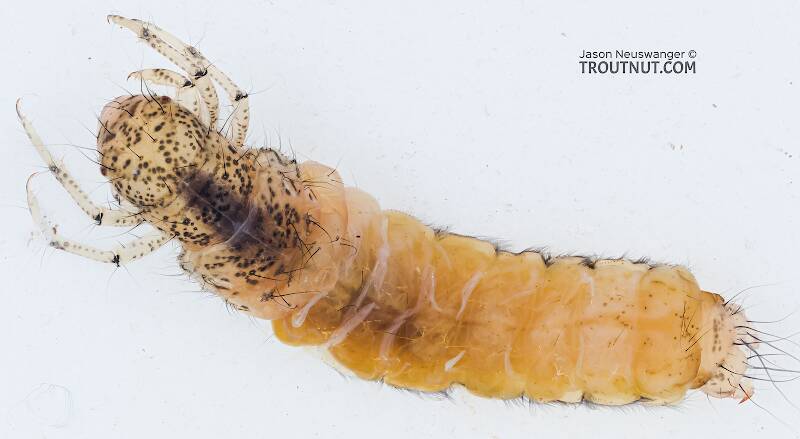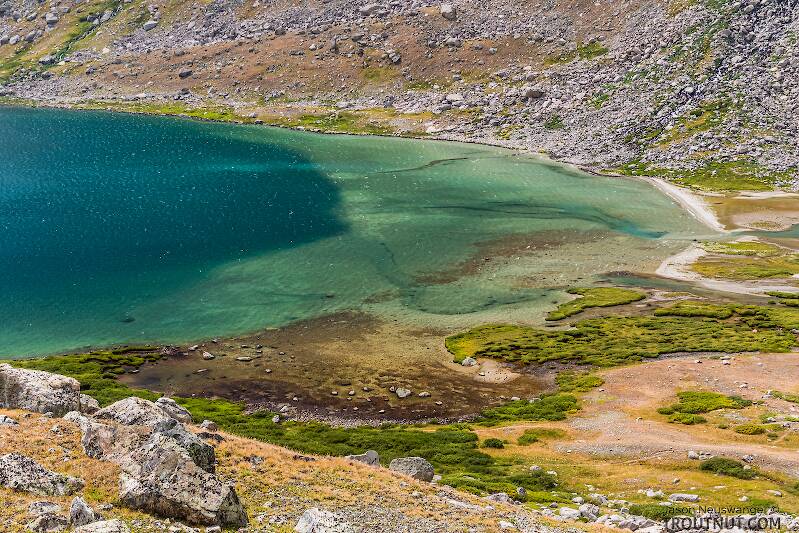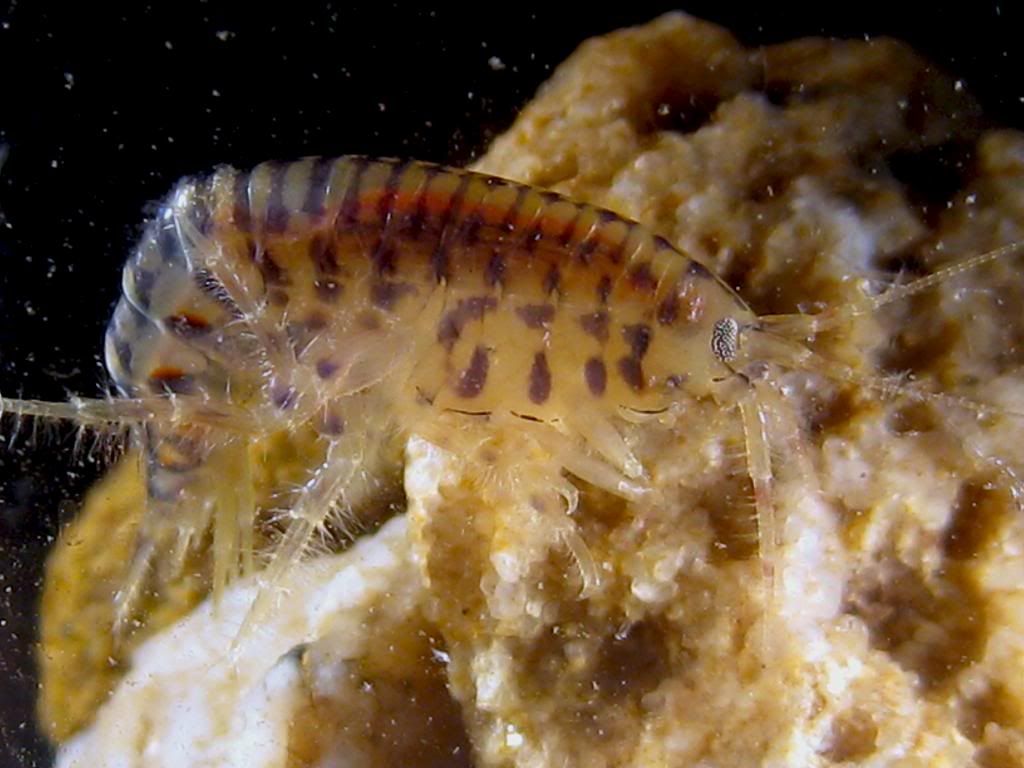
Blue-winged Olives
Baetis
Tiny Baetis mayflies are perhaps the most commonly encountered and imitated by anglers on all American trout streams due to their great abundance, widespread distribution, and trout-friendly emergence habits.
Featured on the forum

This is a striking caddis larva with an interesting color pattern on the head. Here are some characteristics I was able to see under the microscope, but could not easily expose for a picture:
- The prosternal horn is present.
- The mandible is clearly toothed, not formed into a uniform scraper blade.
- The seems to be only 2 major setae on the ventral edge of the hind femur.
- Chloride epithelia seem to be absent from the dorsal side of any abdominal segments.
Based on these characteristics and the ones more easily visible from the pictures, this seems to be Grammotaulius. The key's description of the case is spot-on: "Case cylindrical, made of longitudinally arranged sedge or similar leaves," as is the description of the markings on the head, "Dorsum of head light brownish yellow with numerous discrete, small, dark spots." The spot pattern on the head is a very good match to figure 19.312 of Merritt R.W., Cummins, K.W., and Berg, M.B. (2019). The species ID is based on Grammotaulius betteni being the only species of this genus known in Washington state.
- The prosternal horn is present.
- The mandible is clearly toothed, not formed into a uniform scraper blade.
- The seems to be only 2 major setae on the ventral edge of the hind femur.
- Chloride epithelia seem to be absent from the dorsal side of any abdominal segments.
Based on these characteristics and the ones more easily visible from the pictures, this seems to be Grammotaulius. The key's description of the case is spot-on: "Case cylindrical, made of longitudinally arranged sedge or similar leaves," as is the description of the markings on the head, "Dorsum of head light brownish yellow with numerous discrete, small, dark spots." The spot pattern on the head is a very good match to figure 19.312 of Merritt R.W., Cummins, K.W., and Berg, M.B. (2019). The species ID is based on Grammotaulius betteni being the only species of this genus known in Washington state.

Troutnut is a project started in 2003 by salmonid ecologist Jason "Troutnut" Neuswanger to help anglers and
fly tyers unabashedly embrace the entomological side of the sport. Learn more about Troutnut or
support the project for an enhanced experience here.
Entoman on Mar 5, 2013March 5th, 2013, 9:32 am EST
"It's not that I find fishing so important, it's just that I find all other endeavors of Man equally unimportant... And not nearly as much fun!" Robert Traver, Anatomy of a Fisherman
Crepuscular on Mar 5, 2013March 5th, 2013, 9:55 am EST
I think I should not have bothered posting my photo. You already know what they look like. :)
Entoman on Mar 5, 2013March 5th, 2013, 10:55 am EST
:)
"It's not that I find fishing so important, it's just that I find all other endeavors of Man equally unimportant... And not nearly as much fun!" Robert Traver, Anatomy of a Fisherman
Oldredbarn on Mar 5, 2013March 5th, 2013, 11:21 am EST
Kurt...I'll take a dozen...;)
Is that wrapped partridge?
What size? Both of you...:)
Is that wrapped partridge?
What size? Both of you...:)
"Even when my best efforts fail it's a satisfying challenge, and that, after all, is the essence of fly fishing." -Chauncy Lively
"Envy not the man who lives beside the river, but the man the river flows through." Joseph T Heywood
"Envy not the man who lives beside the river, but the man the river flows through." Joseph T Heywood
Crepuscular on Mar 5, 2013March 5th, 2013, 12:53 pm EST
They come in all sizes from as small as you want to tie to about a 14 scud hook. This one was a size #16.
Entoman on Mar 5, 2013March 5th, 2013, 2:33 pm EST
We get 'em out here up to size 8! Most are in the 12 to 16 range. The partridge is spun in a loop, Spence. The hackles are too short and the barbules too long to wrap conventionally. First dub the thread, form a loop, and insert the barbules to the proper length horizontally on the dubbing and twist the loop up enough to trap them. then trim off the stems along the edge of the thread so the barbule bases don't show. Finish twisting up and wrap on the shank over copious quantities of lead. It's a bit tricky to do. I'm thinking of investing in one of those Petitjean tools to simplify and speed things up...
Most aren't speckled like Eric's specimen. They come in all shades of gray, tan, and olive (some greenish yellow or even peachy cream). I pretty much stick with this aqua tinted gray & partridge and a greenish olive version tied with plain hen hackle. For the tannish ones, I just use a Bird's Nest (as I probably would for Eric's). In sizes 12 - 18, they cover the spectrum for 90% of the ones I've ever run into (of which 75% are covered by the olive). Some of the lakes I have fished (particularly in OR) have the big boys. I just trim up a small Crystal Bugger to deal with those if I have to.
Most aren't speckled like Eric's specimen. They come in all shades of gray, tan, and olive (some greenish yellow or even peachy cream). I pretty much stick with this aqua tinted gray & partridge and a greenish olive version tied with plain hen hackle. For the tannish ones, I just use a Bird's Nest (as I probably would for Eric's). In sizes 12 - 18, they cover the spectrum for 90% of the ones I've ever run into (of which 75% are covered by the olive). Some of the lakes I have fished (particularly in OR) have the big boys. I just trim up a small Crystal Bugger to deal with those if I have to.
"It's not that I find fishing so important, it's just that I find all other endeavors of Man equally unimportant... And not nearly as much fun!" Robert Traver, Anatomy of a Fisherman
Quick Reply
Related Discussions
Topic
Replies
Last Reply
0
Jan 27, 2017
by Mcflyangler
by Mcflyangler






